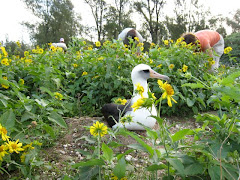

E hō mai ka ʻike mai luna mai ē,
ʻO nā mea huna noʻeau o nā mele ē
E hō mai, e hō mai, e hō mai ē
Give forth knowledge from above
Every little bit of wisdom contained in song
Give forth, give forth, give forth
Cultural Component for PAA Program
by Al Braun
This oli (chant) by Aunty Edith Kanakaole was a fitting beginning to the cultural component of PAA 2010. It is impossible to separate the cultural roots of Pihemanu (Midway Atoll) from its story. Unlike other modules during PAA, the cultural component was woven throughout the entire experience, giving additional insight and perspective to the study of Pihemanu’s history, as well as, it's expected future.
In preparation for our journey to Pihemanu, we spent three days on Oahu learning, growing, and giving to the ‘aina (land) that would ready us for this life changing experience. We learned of the Hawaiian values that are essential for survival on a wa’a (canoe) or a moku (island). These values I was taught as a child resonated with new meaning in this paradigm. Mālama (caring), laulima (working together), kuleana (responsibility), ‘imi’ike (seeking knowledge), aloha (love), na’au pono (doing right), and loko maika’i (sharing) are all needed for a successful voyage, whether that journey is navigating across the Pacific, or navigating a course toward a sustainable future.
We also spent time in Bishop Museum's Hawaiian Hall, where we learned of the culture of a people who crossed the ocean to the world's most isolated archipelago. In the Bishop Museum's archives rooms, we viewed archeological evidence of Hawaiians found on the Northwest Hawaiian Islands of Nihoa and Mokumanamana (Necker Island). We were also able to see examples of kapa, cloth made from wauke (paper mulberry) bark, the scent of which awakened memories of seeing kupuna (elders) making it when I was a young boy.
From Oahu, we travelled on to Pihemanu. When I stepped off the airplane, I was overwhelmed by a sense of awe that I had arrived where the spirits of ancient Hawaiians travelled after leaving this world. The Northwestern Hawaiian Islands were known as Po, the region of primordial darkness where the spirits return after death. This has been a sacred place for generations, and the mana (spiritual power) of this island resonated through and around us.
Throughout our time on Midway, as we absorbed the mana (power) and beauty of Pihemanu, I received many hō’ailona (signs of nature) that spoke to me to pay attention. It was not surprising that in such a sacred place, the messages of the spirit world can transcend the boundaries of the physical world. Ancient Hawaiians knew this to be true, and with each passing day, I became more attuned to the messages being delivered.
Much too quickly, our time in this special place came to an end. The connections I made with myself, my friends, the ‘aina, the creatures, and my ancestors were life-changing. Before departing, I knew that I needed to make a ho’okupu (offering) of thanks to the island in the tradition of my ancestors. My prayer for Pihemanu is one of healing for her and our world.

















No comments:
Post a Comment